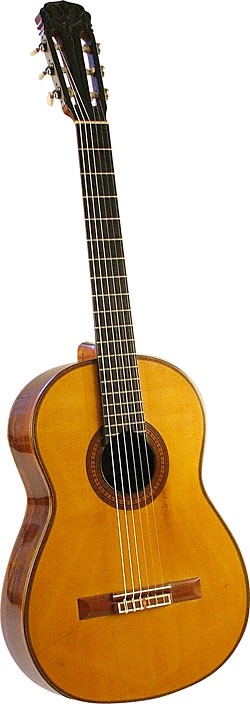
1924 Francisco Simplicio
Francisco Simplicio was one of the most highly regarded Spanish (to be precise, he was Catalan) makers of the first half of the 20th century, being the only student and successor to Enrique Garcia, who worked in both Madrid and later, Barcelona. Simplicio began his guitar making career in 1919 with Garcia after losing his position as an “ebeniste” (highest caliber of cabinet maker) with the firm of Masriera y Vidal of Barcelona, who were makers of deluxe luxury goods. Simplicio had worked for them for 18 years and was already highly skilled as a woodworker. For more on Simplicio’s history, see “Guitars With Guts” in the March ’99 issue
As can be seen here, Simplicio continued using the label of Enrique Garcia, who died October 30, 1922, having completed only 272 guitars under his own name. While one might argue that Simplicio was merely being practical by using up remaining labels left over in the shop, I suspect several other factors influenced his decision. Garcia was the 500-pound gorilla in the guitar-making world when he died, lionized by wealthy players in South America and the rest of the world, and he was hailed as the “Stradivarius of the guitar” in the obituary notices of the era. Convincing players to accept an instrument with an unfamiliar name, no matter how much it looked and sounded like a Garcia would have been an uphill battle. Using the Garcia label, which Simplicio continued until around 1925, fully three years after the death of Garcia, permitted him to over sign them as the “only disciple and student of Enrique Garcia,” thus helping open the way for acceptance of instruments under his own name. It didn’t hurt that Simplicio also retained the original Garcia shop address at Paseo San Juan #110, an address which then and now is in a very expensive and exclusive area of Barcelona. Despite the very high prices their guitars commanded, neither maker felt secure enough to actually print the address on their labels, leaving this detail blank to be filled in by hand on each guitar. Such was the tenuous nature of lutherie in the early 20th century.
In total, Simplicio made 336 guitars under his name between 1922 and his death on January 14, 1932, a pace that works out to being just about 34 guitars per year, a surprising rate of production even if one factors in help from his son Miguel and daughter Josefa. Even the plainest Simplicio guitars carried normal levels of decoration, and his deluxe models were paragons of time-consuming lavish ornamentation, all produced in the Simplicio shop.
This particular example, No. 38 from 1924, harks closer to the original Garcia model, with a more delicate construction and slightly smaller body than Simplicio’s later instruments. It does not have the tornavoz, a brass (or sometimes wooden) inverted cone attached to the underneath side of the sound hole whose function was to deepen the tone of the guitar. The tornavoz was an “improvement” that the jury was still deliberating on in 1924, some players swore by them, others swore at them. Today they are as relevant as a buggy whip.
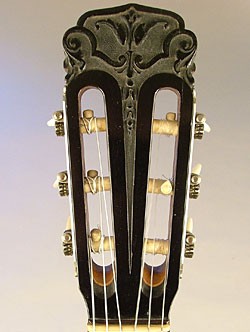
Simplicio head relief carved in ebony.
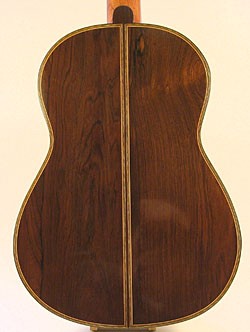
Back of the guitar showing the two halves, not matched.
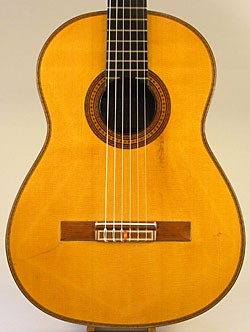
The faint pattern of the fan strutting, where years of exposure to acidic atmosphere caused slightly different levels of oxidation.
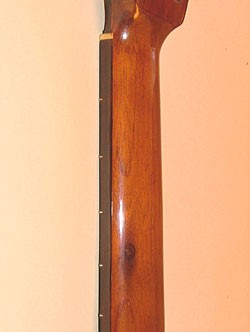
Knot in the Spanish cedar neck, something not considered a fatal defect in those days. Apparently they knew what they were doing, the neck of this instrument is still perfect after more than 80 years under tension.
Made of Brazilian rosewood, it’s curious that the two panels of the back do not match at all, not even close. While today this would be considered a huge defect in an upscale deluxe instrument, in those days players accepted this kind of thing as normal, if not even desirable, as it gives the guitar a very distinctive personality, something entirely lacking in today’s cloned CNC produced products. Like the Garcia models, this guitar is fitted with an asymmetrical fan strutting pattern on the top consisting of eight fans rather than the usual seven symmetrical fans as used by Torres et al. The arrangement of eight fans was a Garcia innovation, which greatly improved the treble response of the guitar. Long-term exposure to an acidic environment has oxidized the very thin (less than 2 mm) soundboard, and now the position of the fan struts is showing through where the top is slightly less oxidized. I have seen this effect in several older thin-topped Spanish instruments that spent many decades residing in cities which suffer from acidic atmosphere such as Buenos Aires, Montevideo, and Chicago. It has no structural consequence whatsoever.
The scale of this guitar measures exactly 251/2″ (647 mm) the same as used by Antonio de Torres in the 19th century, who used tools and measuring devices that were probably English in origin. Later Simplicio guitars beginning around 1927 have slightly larger bodies and a scale measuring 650 mm, or 255/8″. Unfortunately, we don’t have any written correspondence from Simplicio that would shed light on his reasons for this change, but the desire for more volume (thanks to more tension on the longer scale) and greater depth (due to a larger internal air volume) would have been the factors Simplicio would have understood to control the sound.
Simplicio used many different patterns for the head profile and carvings, as did Garcia before him. This was an area where they exerted their artistic creativity. When it came to the rosettes and purflings, it’s clear that while several distinctive patterns were used, these were items made in large quantities and stockpiled in the shop in the various individual components, which allowed not only mix and matching from instrument to instrument, but also some degree of consistency, without the boring perception that everything was assembled from one parts box.
Like Torres in the 19th century, Garcia and Simplicio both scraped the corners of their instruments thinner before cutting the purfling channels, which gives their instruments a soft roundness just like those of Torres. By 1927, when Simplicio was making his larger model, he discontinued this time-consuming practice, giving his later guitars a much more masculine appearance. Internally, Simplicio used molded kerfed linings of cedar and pine, which ingeniously provided adequate internal support for the wide, elaborate external inlays and purflings without making the instrument noticeably heavier. The only defect of Simplicio in my opinion was cutting entirely through the back and top surfaces to glue all this extensive inlay directly to the linings, instead of having them glued to a ledge cut halfway into the thickness of the back. The difference is apparent if one ever has to remove the highly decorated back from a Simplicio in order to do extensive internal repairs. This is an operation never to be done in the presence of dogs or small children!
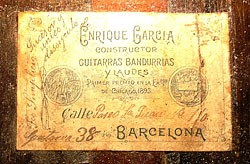
Garcia label showing Simplicio’s over-written signature.
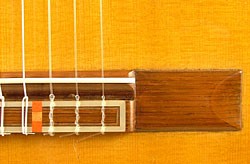
The precise bridge work. Note the perfect miters of the mother of pearl, and the perfect facets on the ends of the thin arms.
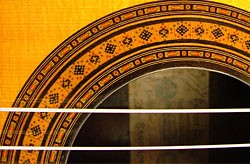
Detail of the Simplicio rosette. The mosaic border is made to imitate the printed border of one of the segunda época labels used by Antonio de Torres. The same mosaic is used to border the entire sound board margin.
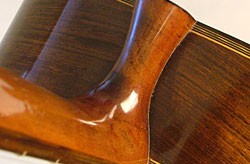
The rounded Simplicio heel. Garcia’s and Simplicio’s esteem in South America was so great that nearly all South American makers today favor the rounded heel in homage to these pioneers. Of course Garcia and Simplicio were only following the lead of Torres, who also used the rounded heel.
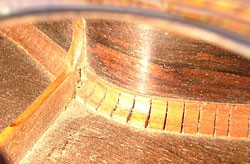
The interior back linings, carefully molded and kerfed. Note the precise fit of the crass strut against the linings, and the support block on the end of the cross strut.
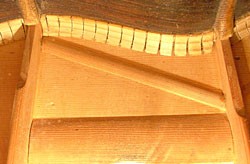
Interior, showing top linings and soundhole braces. Simplicio has also used heavy paper to partially reinforce around the soundhole, an ancient practice among Spanish makers.
The Simplicio bridge is worthy of close attention, being both delicate and very precisely formed. The arms are very thin and flexible, delicate to an extreme, and the tie block is quite wide and large, inlaid very precisely with mother of pearl and very delicate purflings. As you may note, the tie block inlay is set within the width of the full tie block, which visually lightens the very wide central area of the bridge. The arms are so delicate that the valley is not undercut, despite the very low position of the string holes. The ends of the tie block and saddle area are precisely and gently rounded over to lighten the bridge and soften the corners. The bridges of Ignacio Fleta immediately come to mind when viewing Simplicio’s (and Garcia’s) bridges. Few makers used bridges of such consistent acoustical design as did Simplicio, who left nothing to chance with this detail. While I’ve heard it suggested that the central wood tripartite inlays found in some Simplicio tie blocks indicated export models, I have not found that to be consistently the case, there being several Simplicio guitars which would contradict this traditional legend.
Like most guitars from the 19th and early 20th century, this guitar was originally intended to carry a very low action, but it has been fitted with a slightly higher saddle to bring the action more in line with modern classical guitar action, and it is a testimony to the genius of Simplicio’s art that the top shows no distortion nor problems despite the change of intended torque. For many older Spanish instruments this kind of action change can be very detrimental to the integrity of the top. Typical of Simplicio guitars, the fingerboard is much thicker at the nut end than other Spanish instruments of the era, part of Simplicio’s approach to achieve the correct action. The thicker fingerboard also helps give the instruments more sustain and “singing” quality.
Like all unaltered Simplicio guitars, this one is finished in “goma laca,” as the Spanish call it, or “French polish” as we English speakers like to call it, a varnish consisting primarily of shellac dissolved in ethyl alcohol applied very thinly with a pad lubricated with olive oil. Whoa… I think I just gave away some important varnish secrets! Well, there is a small matter of experience in doing this, too. Simplicio did his own varnishing using various grades of shellacs, as shown in a photo of he and son Miguel working in the shop, something that was not universally done by Spanish makers. This being a highly skilled trade, often, makers would entrust their instruments to specialist polishers who would do the varnishing for them, a tradition that lives on today in Spanish instruments of various Madrid builders who send their guitars out to Earl Scheib to be sprayed with modern catalyzed urethane. Due to repairs over the years, like so many older Spanish instruments, this guitar has acquired newer paddings of french polish (goma laca, shellac) on top of the original varnish, something entirely acceptable provided the original is not scraped off and the instrument sanded to bare wood. Among luthiers, this radical stripping procedure is known as the Phyllis Diller facelift.
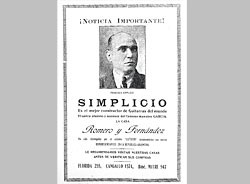
Advertisement from the catalog of Romero y Fernández of Buenos Aires. It reads, “Important announcement! Simplicio is the best guitar maker in the world, the only student and successor of Garcia. The house of Romero y Fernández has been appointed by the celebrated luthier as the exclusive representative in the Argentinean Republic. We recommend that you visit our showrooms before making your purchase.”
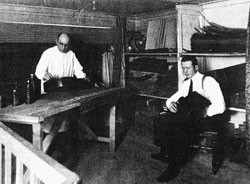
Francisco Simplicio (left) and son, Miguel, applying French polish in their shop. On the shelf between them one can see fret wire in coils on the top left shelf, with spruce soundboards leaning vertically next to them. On the shelf below are stacks of partially finished necks and heads with fingerboard blanks behind them. On the top shelf above Miguel are stacks of unbent sides topped with inlay materials and purflings, and on the middle shelf are sets of bent sides. On the bench are bottles of shellac, alcohol, and olive oil, and both are working with what the Spanish call the “muñeca” or doll, which is a wad of cheesecloth wrapped with pure linen used to apply the shellac in molecularly thin coats using thousands of passes over the surface. The wall behind Francisco is actually a roll down security gate which opens directly to the street in front of the shop. It is interesting that they have closed this gate for the varnishing process. Normally they would have been working in open air. The building still exists, though the roll-down gates have been replaced with windows.
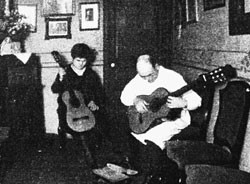
Josefa (left) and Francisco Simplicio working in their home. Though Francisco’s letters mention his daughter, Josefa, it is not clear what role she played in the operation. But she must have been very helpful, there is no way Francisco and Miguel could produce 34 guitars a year without help.
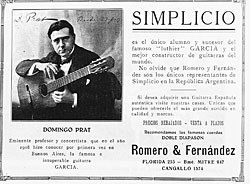
Advertisement from the July, 1926, issue of the Revista Tárrega. It reads, “Simplicio is the only student and successor of the famous luthier Garcia and the best maker of guitars in the world. Don’t forget that Romero y Fern#225;ndez are the only representatives of Simplicio in the Argentinean Republic. If you would like to acquire an authentic Spanish guitar, visit our showrooms. We are the only ones who can offer you the largest selection of quality and brands.” Domingo Prat is featured prominently in the ad, with the legend, “Eminent professor and concert artist who in the year 1908 introduced for the first time in Buenos Aires the famous and incomparable GARCIA guitar.” Curiously, the photo shows Prat actually holding what looks to be either a Manuel Ramírez or Domingo Esteso guitar. Of course, those were incomparable, too.
Simplicio liked to varnish the interior sides and back of his guitars, presumably to slow down the loss of moisture when they were taken to dryer climates where cracking was a distinct risk. In those days, makers had no practical way to control humidity in their shops short of closing the window when it was raining outside. Indeed, there are several repaired cracks in the back of this instrument which is quite thin (less than two millimeters). While internal varnishing might slow down the loss of humidity, it certainly does not prevent it, and further complicates the later repair of the instrument if cleat work is needed. Ignacio Fleta, who was just getting started as a luthier when Francisco Simplicio died also followed this concept of finishing the interior of the sides and back, and had no more success at preventing cracks than did Simplicio. Some makers today still follow this theory. Hope springs eternal.
The machine heads of this Simplicio are the original German silver machines with mother-of-pearl buttons and the patented pips screwed to the rollers which were favored by Garcia and Simplicio. The difficulty of removing these machines has helped to preserve the instruments from casual and amateur refinishing, the leading cause of death for many other fine Spanish guitars. German-made, the quality engineering of these machines has kept them fully functional for nearly a century, and they show no signs of imminent demise. It was a hallmark of Simplicio to use nothing but the finest tuning mechanisms, which were German made, and must have been frightfully expensive in their day. Simplicio’s clientele did not care, they wanted the best, and Simplicio spent his entire lifetime making the best – “Ars longa vita brevis,” as they say.
Acknowledgments: Sincere thanks to Randy Osborne of Fine Fretted Stringed Instruments, Campbell, California, for allowing me access to his historical archives of material from which I obtained the advertisements for Simplicio’s guitars and the photos of the Simplicios in their shop. This and much more material is set to appear in his soon to be published book, Annotations for the History of the Classical Guitar in Argentina.
Richard Bruné began making guitars in 1966 and is a former professional flamenco guitarist. He has written for the Guild of American Luthiers and other organizations and lectured at guitar festivals and museums including the Metropolitan Museum of Art in New York City. He collects classical and flamenco guitars. He was recently featured on the PBS documentary, “Los Romeros: The Royal Family of the Guitar,” and his new book, The Guitar of Andrés Segovia: Hermann Hauser 1937, was recently published by Dynamic, of Italy. You can write to him at 800 Greenwood Street, Evanston IL 60201, or visit rebrune.com.
This article originally appeared in VG‘s July 2009 issue. All copyrights are by the author and Vintage Guitar magazine. Unauthorized replication or use is strictly prohibited.


